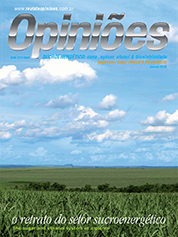Plinio Mário Nastari
President of Datagro Publicações
Op-AA-25
Current scenario
As sugarcane crushing reaches approximately 660 million tons in the 2010/11 harvest season, which amounts to more than 30% of the sugarcane produced in the world, the scenario in Brazil’s sugar and ethanol industry is quite different from what it was before the diversification process towards ethanol started. The difference begins with the production scale.
In 1975, when 68 million tons were crushed, the industry was dominated by traditional mills, then just recently modernized by the Funproçúcar program of the now extinct IAA - Instituto do Açúcar e do Álcool (Sugar and Ethanol Institute), which in 1974 handed out abundant funds originated from the very high international sugar prices at the time, that in turn fed the IAA’s accounts through exports under control of the government monopoly.
At that time, autonomous distilleries started to be installed, with production modules of 120,000 to 180,000 liters per day and representing crushing of 400,000 to 500,000 tons of sugarcane per harvest. These were modern mills at the time, viewed as efficient according to the then prevalent standards. Starting in 1989, government regulations and intervention were eliminated in a process that lasted for 10 years (until 1999).
Production and sales quotas were eliminated, along with crop plans, the need for authorizations to move inventories, as well as controlled prices and, in the early days, subsidized financing. Slowly the production of sugar grew, with the industry diversifying at an increased pace and both sugar and ethanol markets expanding as well.
Nowadays, no new industrial plant project is undertaken for a scale of less than 2 million tons and usually the planning is already done aiming at doubling or tripling these plants’ capacity in the medium term. Agricultural activities are developed according to a production model of an agricultural enterprise, in which companies seek to optimize the use of the existing capacity of equipment and machinery employed in mechanized planting and harvesting.
This is the reality applicable both to mills and suppliers. In most sugarcane producing countries, however, the agricultural production is still brought about by small and medium size planters, without the use of machinery and in three work shifts, along with the use of efficient preventive maintenance programs. One should emphasize the current ability to quickly develop new projects in regions lacking labor and basic inputs, that have no infrastructure in terms of roads and energy distribution systems.
Nevertheless, new mills are appearing in new regions, resulting in rapid growth of the crushing capacity, a high degree of agricultural mechanization and the use of industrial automation. The use of onboard computers in agricultural equipment, of GPS devices for planting and harvesting, online control of each operation and the possibility to use remote control through a laptop located thousands of kilometers away, started to be expected and became common activities in Brazil’s current sugar and ethanol industry.
While all this modernization results in savings and cost reductions, on the other hand labor’s qualification is improving, whether due to competition or regulations. The remuneration standard increased considerably at all levels, allowing a significant increase in revenues in regions where the industry sets up activities. Apart from generating a lot of revenues, production takes place in many links of a long production chain, quite different from that of cattle breeding or even numerous other agricultural and agro-industrial activities.
This differential is clearly perceivable in the economic development of regions in which cattle breeding on a broad basis and the integrated production of sugarcane are prevalent. The appearance of large economic groups, a trend accelerated by the consolidation process that resulted from the recent price and liquidity crises, brought about the creation of industrial clusters, with considerable reductions in unitary fixed costs, while allowing for more efficient management of purchasing, logistics, use of inputs and the employment of key workers.
Nowadays, the industry is mostly verticalized upwards and downwards, resulting in savings and allowing value aggregation in the various links of the production and sale chain. Diversification is quickly developing towards the full utilization of sugarcane, initially through co-generation, but it may soon develop to the production of ethanol. The transformation of saccharose into products of higher aggregated value is a reality that is beginning to take shape as in the case of green polyethylene, advanced hydrocarbons and a huge chain of ingredients in the food industry.
Nowadays, the industry is less widespread but more professional and with better access to resources and financing. The scenario in the sugar and ethanol industry today is no longer that of an unfinished works. It is still in transformation with respect to its degree of production and sales concentration. It is also undergoing technological transformation and is in the process of becoming a global player in the energy field. In the food industry, it has become a global leader, given that it has not met with competition in the diversification process set up 35 years ago, thus having been able to achieve control over more than 50% of the world’s sugar exports.
In the ethanol area, global development has a positive outlook, particularly due to the reduction potential of current barriers to free trade. Better than the scenario, one must acknowledge that to describe this industry one must imagine a movie, and that this movie was previously shown in black and white and then gradually became a color movie. It is now in the process of becoming a 3D mega production.




